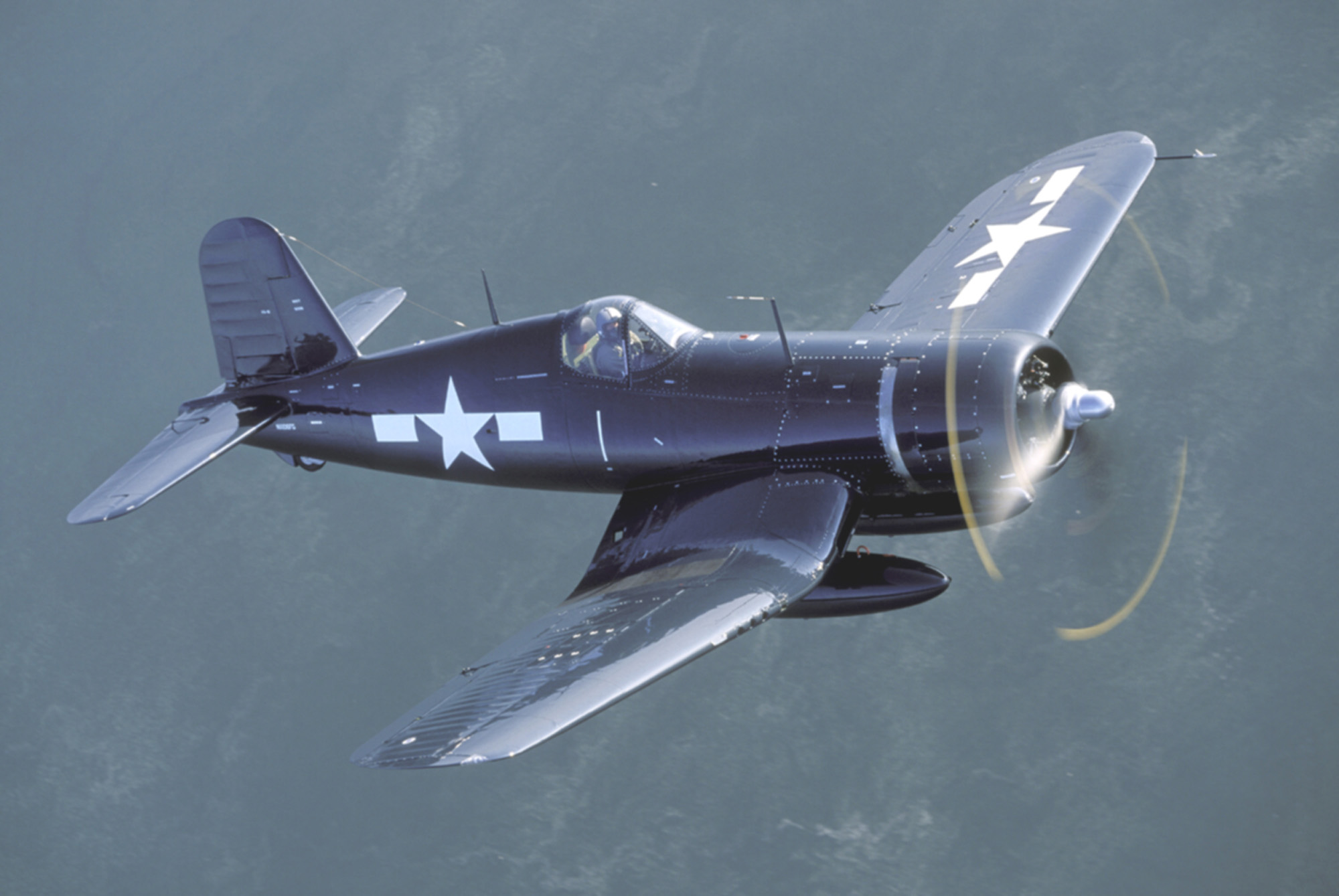By Terry Stephens
Hundreds of thousands of people of all generations admire the warbirds of World War II, parading by them in aviation museums, staring at them at air shows and craning their necks to watch them in flyby formations.
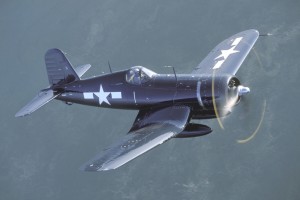
John Lane Jr., founder of Airpower Unlimited, has established an international reputation for exquisite restorations of World War II fighter planes, like this Corsair that Lane is flying.
They are more than metal, glass and fabric flying machines. Those planes represent America’s courageous and successful airpower response to aggression by foreign forces. Now, more than 60 years after those bombers and fighters played lead roles on the wartime world stage in the European and Pacific theaters, hundreds have been salvaged from military surplus storage centers, hauled from the depths of lakes, rescued from scrap piles and pieced together in near-perfect restorations.
According to the best estimates of the Experimental Aircraft Association in Oshkosh, Wis., there are 1,056 warbirds in aviation museums, 684 planes are flying, 458 are being restored and 522 are in storage. With collectors always on the lookout for more, American World War II planes are being found in Russia and other old war zones, as well as in Third World countries that are trading in their aging propeller aircraft for early model military jet fighters.
But as fascinating as the planes themselves are, so are the stories of those who restore them. A small group of people have the skills, knowledge and passion to rebuild these giant pieces of flying history for the world to see for years to come—people like John Lane Jr. of Airpower Unlimited in Jerome, Idaho.
“The whole issue for vintage warbird restorers is having the passion for this work. This is not just an eight-hour-a-day job,” Lane said.
Specializing in F4U-5 Corsairs, he has also restored a TBM Avenger, P-51 Mustang, L-5 Sentinel, Hawker Hurricane, SNJ-6 Texan, A-26 Invader, T-28 Trojan and a P2V Harpoon, a maritime patrol plane that evolved from the Lockheed Hudson bomber, based on Lockheed’s civilian Super Electra. Museums and private warbird owners regularly contact him for restoration projects and his annual visits to EAA AirVenture Oshkosh always turn up new contacts and new projects.
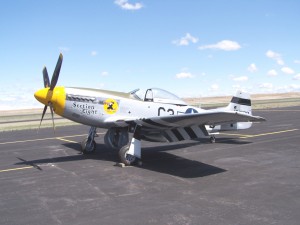
John Lane’s Airpower Unlimited crew recently restored this P-51, Section Eight. The Mustang is often flown at Pacific Northwest air shows by Idaho pilot and owner Doug Driscoll.
Perhaps more than any other of his credentials, a single line in his background profile sums up his stature in the realm of warbird restorers: his role as the former director of maintenance and restoration for Doug Champlin’s famous Champlin Fighter Museum in Mesa, Ariz. Lane spent five years there, restoring and maintaining Champlin’s rare collection of American and Allied World War II and World War I fighters.
Today, Champlin’s priceless array of aviation history is on display at The Museum of Flight in Seattle, housed in the specially built, climate-controlled $53 million, 88,000-square-foot J. Elroy McCaw Personal Courage Wing that opened in mid-2004. The facility showcases 28 historic fighter planes, including the Spitfire, Soviet Yak, Messerschmitt Bf-109E and Lockheed’s deadly and powerful P-38.
The P-38, above all others, has played a key role in Lane’s life and passion for restoring aging warbirds. His father, John Lane Sr., became a six-victory ace in the air war over the Pacific while flying the P-38 Lightning. During the war, his father flew 220 missions and more than 500 hours of combat flying, including missions in P-47 Thunderbolts. Lane described his father, who died in 1984, as a humble person.
“He was a patriot who made me who I am today,” he said. “He really was a great inspiration for what I do today. … When I fly these planes, I feel his presence. I know he’s with me. I think he’d be very proud of what I’m doing.”
Restoring historic World War II warbirds is a tribute to his father and to all those courageous pilots who fought in that war, he said. He finds the work rewarding whenever the planes return to the air or go on public display.
He has personally taken many restored warbirds airborne once again. He’s logged 6,500 hours and flew at least 90 different models of World War II aircraft. These include the P-40 Warhawk, P-51 Mustang, P-47 Thunderbolt, P-38 Lightning, F4F Wildcat, F6F Hellcat, F4U and FG-1 Corsairs, Hawker Sea Fury, B-25 Mitchell, A-26 Invader, TBM Avenger torpedo bomber, Douglas C-54 Skymaster and nearly all of the training planes of the Army Air Force in the 1940s.
Lane has always been fascinated with World War II aircraft, even though his esteemed father tried to discourage him from flying, particularly what he called “that old junk.” Lane was born in California, but his family moved to Arizona for his father’s work with the railroad. In the mid-1960s, while in Winslow, Ariz., Lane began flying a Commonwealth Skyranger, then soloed in a Champ.
Hanging around airports, he picked up flying time and jobs. Before long he’d flown the PT-17, PT-22 and then the Texan, later getting into flying the Mustang, Corsair, Thunderbolt and C-54s, B-17s and PB4Y-2s that had been converted into fire bombers. Although he kept flying whenever he could, particularly warbirds, he spent 20 years developing a career in building race cars and engines.
During those years, he and a friend found an opportunity to buy and restore a B-25 that had been Gen. Dwight Eisenhower’s personal aircraft during the war. A founding member of the Arizona chapter of the Confederate Air Force (now Commemorative Air Force) at that time, Lane agreed to help restore and maintain a friend’s newly acquired B-17G.
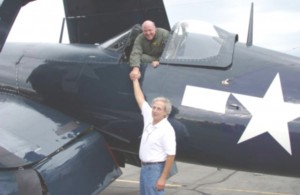
After this restored FG-1D Corsair’s first flight following 13 years of restoration, Gary Kohs of Royal Oak, Mich., warbird pilot and the plane’s owner, greets restorer John Lane.
In 1980, he converted his aviation hobby into fulltime work when he joined the Champlin Fighter Museum to do restoration and maintenance work. Then, after five years with Champlin, he moved to Idaho to work on TBMs that had been converted to sprayers and tankers and were being returned once again to warbird configurations. By 1987, he’d launched his new warbird restoration business, Airpower Unlimited in Twin Falls, Idaho. Two years later, the growing business moved to its present site in a 7,500-square-foot hangar at Jerome County Airport (JER).
“It’s been a win-win situation for us, moving to Idaho,” he said. “I wanted to get away from the rat race and enjoy the outdoors of the Northwest. It’s been great for people here, too. Our restoration team includes all home-grown folks. People kept coming to me wanting jobs. They not only had the credentials, but they also had the passion that’s needed to restore warbirds. It not only makes for fun but also makes everything come together so nice. We don’t have much turnover in people.”
Although his website has interesting features about his business and a list of completed and pending projects in the hangar, Lane admits it’s about four years behind.
“We’re getting close to updating it, but we’ve just gotten too busy,” he said. “Every project we finish is a big deal for us and we celebrate it.”
In addition to restorations, Lane provides teardown inspections and maintenance for owners of a variety of warbirds. His latest project rolled out of the hangar a few weeks ago. The P-51 was restored for Doug Driscoll of American Falls and is flown locally in Idaho.
Lane’s own P-51 also flies locally. In June, he was scheduled for back-to-back air shows, one in Boise for the Warhawk Air Museum fly-in and the following week at a show in Rexford.
“Often customers will ask me to fly their bombers or fighters in air shows and I try to get to the EAA show at Oshkosh each year because it’s important for me to be there among the folks. When they ask questions and talk with me, before long I know someone will be telling me about a new project. About everything we do is from word-of-mouth promotion,” he said.
In such a time-consuming business, it’s fortunate that Lane’s wife, Nancy, is equally involved.
“She grew up in an aviation family,” he said. “Her dad and brother both fly so there have always been planes and helicopters in her life. She’s very well versed in this lifestyle. Also, we share a passion for World War II history. Collecting memorabilia is just a part of both of us and who we are. She’s also my office manager, partner-in-crime and so on. She runs everything here.”
Lane’s first Airpower Unlimited project in Idaho was one of his most difficult and meticulous. It was the restoration of a Vought/Goodyear FG-1D Corsair that had been buried in the bottom of Seattle’s Lake Washington for decades. After World War II, when it had served aboard the carrier USS Intrepid, the plane was assigned in 1945 to Naval Air Station Sand Point in Seattle, near the north end of Lake Washington. In July, Commander Ralph Mileson ditched the Corsair in the lake as he tried to reach the airfield following a midair collision with another Corsair.
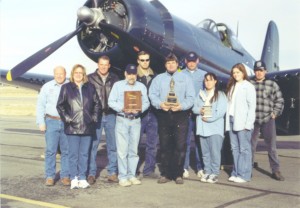
The restoration of Gary Kohs’ FG-1D Corsair won the Grand Champion award at EAA AirVenture Oshkosh in 2003 and a second EAA Golden Wrench award for the restoration crew, shown here with John and Nancy Lane on the left.
Fortunately, there were no fatalities in the accident, but Mileson’s aircraft wasn’t found until decades later. It was raised from the muck and debris of the lakebed in 1983. In three years, Lane restored it to an exacting out-of-the-factory, ready-to-fly condition.
“The Navy, however, still had control of that warplane and didn’t want anyone but Navy personnel flying it. So, even though it was definitely flyable, it was just put on display at The Museum of Flight,” he said. Today, on loan from the Navy, the plane Lane and his crew restored rests in the museum’s Great Gallery, recognized as one of the most authentically restored aircraft ever exhibited there.
Another Corsair restoration, an FG-1D, was completed in 2003 for pilot-owner Gary Kohs, owner of Fine Art Models of Royal Oak, Mich., a company known for its exceedingly accurate museum quality models of ships, trains, automobiles and fighter planes. The plane came from the collection of David Tallichet in Chino, Calif., who founded Yesterday’s Air Force in the 1970s, then changed the name to the Military Aircraft Restoration Corp. Today, it’s a private company known for dozens of recoveries of derelict warbirds and occasional restorations. Kohs’ Corsair once flew in the 1970s television series “Baa Baa Black Sheep,” loosely based on the war stories of “Pappy” Boyington, a U.S. Marine Corps pilot with 22 combat victories and leader of a squadron of Corsairs stationed in the Pacific during the war.
The 13-year project took 17,000 hours of work but the finished, “as delivered by Goodyear” quality of Kohs’ Corsair restoration won a World War II Grand Champion award at EAA AirVenture Oshkosh that same year. Of the 12,654 Corsairs built between 1943 and 1952—originally by Chance Vought and later by Brewster and Goodyear—records show that Goodyear produced 4,017 of the distinctively designed planes.
John Lane’s exquisite work on the Corsair also earned a second Golden Wrench award for Airpower Unlimited for his crew’s superb work. His team of artisans completely stripped and disassembled the Corsair, rebuilding it with original parts whenever possible and following original Goodyear factory assembly plans. When necessary, Airpower Unlimited reconstructed new parts. The first EAA Golden Wrench honor for the company was presented in 1996 for their restoration of a Navy TBM torpedo bomber.
It takes years, even decades, to build a solid reputation in the realm of warbird restoration work. John Lane Jr. has done just that, from Arizona to Idaho, from Corsairs to Mustangs. As a pilot and a craftsman with exacting standards, Lane has proven he’s a man with a passion for preserving and honoring warbirds and their pilots of more than 60 years ago—including, of course, his father.
For more information, visit [http://www.airpowerunlimited.com]. You can contact John Lane Jr. at 208-324-3650 or by email at jlane@mindspring.com.











